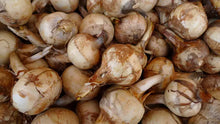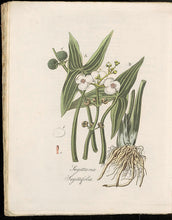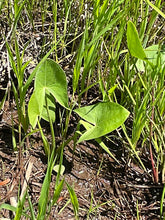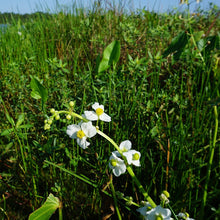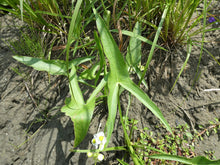'Mahicannittuk' Katniss (Wapato or Duck Potato)
Regular price
$5.00
Sale
Sagittaria latifolia
Origin: Mahicannittuck (Hudson River), New York
Improvement status: Wild
Seeds per packet: ~30
BOTANICAL SAMPLE - NOT GERMINATION TESTED
Life cycle: Perennial
Katniss is a beautiful aquatic perennial vegetable long eaten by Indigenous peoples from what's now called Canada south to Ecuador. Cousins of the plant are eaten around the world. The late summer buds and young fruits are also edible, but its the large underwater tubers that are most widely consumed. "Katniss" is the Lenape name — used by the original inhabitants of the region where this seed was foraged — but the Chinook name "wapato" is more commonly used, especially in and around the Chinook homeland in what we call the Pacific Northwest today. Other names include "duck potato" (though ducks pretty much only eat the seeds) and "broadleaf arrowhead." Our seed was foraged by EFN co-founder Nate Kleinman in a marsh on the edge of the Mahicannittuk ("river that flowers both ways" or "waters that are never still"), or Hudson River.
The tubers of katniss float, so the traditional method of harvesting involves dislodging them with one's feet (or a stick or a pitchfork) and then grabbing the tubers once they rise to the surface. After harvesting, tubers can be eaten raw (when they can be somewhat bitter) or cooked or dried and pounded into flour. Pretty much anything you might do with a potato you can do with katniss (the great forager, cook, and all-around awesome human Linda Black Elk told us she once made some excellent katniss latkes — Jewish-style potato pancakes). Roasted, fried, boiled, steamed, sauteed, mashed, etc. The tubers are incredibly nutritious, rich in protein, Vitamins B1, B5, B6, as well as iron, magnesium, manganese, phosphorus, and potassium. Beavers, muskrats, and porcupines eat the whole plant, including the tubers.
GROWING TIPS: Katniss grows in shallow water (roughly half a foot deep to a foot and a half deep) that is still or barely moving. It is usually found around the edges of wetlands like ponds, swamps, marches, old canals, and slow-moving streams or rivers. Plants for a Future offers these tips on growing from seed: "Best sown as soon as it is ripe in a pot standing in about 5cm of water. Prick out the seedlings into individual pots when they are large enough to handle, and gradually increase the depth of water as the plants grow until it is about 5cm above the top of the pot. Plant out in late spring or early summer of the following year. Division of the tubers in spring or autumn." Seeds require a cold-warm-cold cycle to germinate, so they might not sprout for a full year after planting. If you have a pond or access to an appropriate body of water for these, we recommend simply sprinkling some seeds around the edge as soon as you can. Within a couple years you should notice the graceful arrowhead-shaped leaves emerging from the water.






